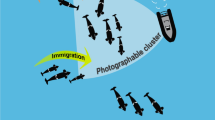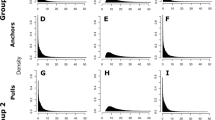Abstract
One of the hardest problems in studying animal behaviour is to quantify patterns of social interaction at the group level. Recent technological developments in global positioning system (GPS) devices have opened up new avenues for locating animals with unprecedented spatial and temporal resolution. Likewise, advances in computing power have enabled new levels of data analyses with complex mathematical models to address unresolved problems in animal behaviour, such as the nature of group geometry and the impact of group-level interactions on individuals. Here, we present an information theory-based tool for the analysis of group behaviour. We illustrate its affordances with GPS data collected from a freely interacting pack of 15 Siberian huskies (Canis lupus familiaris). We found that individual freedom in movement decisions was limited to about 4%, while a subject’s location could be predicted with 96% median accuracy by the locations of other group members. Dominant individuals were less affected by other individuals’ locations than subordinate ones, and same-sex individuals influenced each other more strongly than opposite-sex individuals. We also found that kinship relationships increased the mutual dependencies of individuals. Moreover, the network stability of the pack deteriorated with an upcoming feeding event. Together, we conclude that information theory-based approaches, coupled with state-of-the-art bio-logging technology, provide a powerful tool for future studies of animal social interactions beyond the dyadic level.




Similar content being viewed by others
References
Ákos Z, Beck R, Nagy M, Vicsek T, Kubinyi E (2014) Leadership and path characteristics during walks are linked to dominance order and individual traits in dogs. PLoS Comput Biol 10(1):e1003446
Altmann J (1974) Observational study of behavior: sampling methods. Behaviour 49(3–4):227–266
Azzi A, Evans JA, Leise T, Myung J, Takumi T, Davidson AJ, Brown SA (2017) Network dynamics mediate circadian clock plasticity. Neuron 93(2):441–450
Bialek W, Cavagna A, Giardina I, Mora T, Silvestri E, Viale M, Walczak AM (2012) Statistical mechanics for natural flocks of birds. Proc Natl Acad Sci 109(13):4786–4791
Bonanni R, Cafazzo S (2014) The social organisation of a population of free-ranging dogs in a suburban area of rome: a reassessment of the effects of domestication on dogs’ behaviour. In: The social dog, Elsevier, pp 65–104
Branson K, Robie AA, Bender J, Perona P, Dickinson MH (2009) High-throughput ethomics in large groups of drosophila. Nature Methods 6(6):451
Cafazzo S, Valsecchi P, Bonanni R, Natoli E (2010) Dominance in relation to age, sex, and competitive contexts in a group of free-ranging domestic dogs. Behavioral Ecol 21(3):443–455
Cafazzo S, Bonanni R, Valsecchi P, Natoli E (2014) Social variables affecting mate preferences, copulation and reproductive outcome in a pack of free-ranging dogs. PLoS One 9(6):e98594
Cafazzo S, Lazzaroni M, Marshall-Pescini S (2016) Dominance relationships in a family pack of captive arctic wolves (Canis lupus arctos): the influence of competition for food, age and sex. Peer J 4:e2707
Couzin ID, Krause J, James R, Ruxton GD, Franks NR (2002) Collective memory and spatial sorting in animal groups. J Theor Biol 218(1):1–11
Couzin ID, Krause J, Franks NR, Levin SA (2005) Effective leadership and decision-making in animal groups on the move. Nature 433(7025):513
Dahl CD, Wyss C, Zuberbühler K, Bachmann I (2018) Social information in equine movement gestalts. Anim Cogn 21(4):583–594
Dankert H, Wang L, Hoopfer ED, Anderson DJ, Perona P (2009) Automated monitoring and analysis of social behavior in drosophila. Nature Methods 6(4):297
De Chaumont F, Coura RDS, Serreau P, Cressant A, Chabout J, Granon S, Olivo-Marin JC (2012) Computerized video analysis of social interactions in mice. Nature Methods 9(4):410
Dell AI, Bender JA, Branson K, Couzin ID, de Polavieja GG, Noldus LP, Pérez-Escudero A, Perona P, Straw AD, Wikelski M et al (2014) Automated image-based tracking and its application in ecology. Trends Ecol Evol 29(7):417–428
Ferdinandy B, Ozogány K, Vicsek T (2017) Collective motion of groups of self-propelled particles following interacting leaders. Phys A Stat Mech Appl 479:467–477
Fruchterman TM, Reingold EM (1991) Graph drawing by force-directed placement. Softw Pract Exp 21(11):1129–1164
Gadbois S (2002) The socioendocrinology of aggression-mediated stress in timber wolves (Canis lupus. Thesis. Dalhousie University, Halifax, Nova Scotia
Gammell MP, Vries HD, Jennings DJ, Carlin CM, Hayden TJ (2003) David’s score: a more appropriate dominance ranking method than clutton-brock et al.’s index. Anim Behav 66(3):601–605
Gerencsér L, Vásárhelyi G, Nagy M, Vicsek T, Miklósi A (2013) Identification of behaviour in freely moving dogs (Canis familiaris) using inertial sensors. PloS One 8(10):e77814
Kobourov SG (2012) Spring embedders and force directed graph drawing algorithms. arXiv preprint arXiv:12013011
Kubinyi E, Wallis LJ (2019) Dominance in dogs as rated by owners corresponds to ethologically valid markers of dominance. Peer J 7:e6838
Kummer H (1984) From laboratory to desert and back: a social system of hamadryas baboons. Anim Behaviour 32(4):965–971
Langford DJ, Crager SE, Shehzad Z, Smith SB, Sotocinal SG, Levenstadt JS, Chanda ML, Levitin DJ, Mogil JS (2006) Social modulation of pain as evidence for empathy in mice. Science 312(5782):1967–1970
Lukeman R, Li YX, Edelstein-Keshet L (2010) Inferring individual rules from collective behavior. Proc Natl Acad Sci 107(28):12576–12580
Marshall-Pescini S, Cafazzo S, Viranyi Z, Range F (2017) Integrating social ecology in explanations of wolf-dog behavioral differences. Curr Opin Behav Sci 16:80–86
Mech LD (1999) Alpha status, dominance, and division of labor in wolf packs. Can J Zool 77(8):1196–1203
Nagy M, Akos Z, Biro D, Vicsek T (2010) Hierarchical group dynamics in pigeon flocks. Nature 464(7290):890
Packard JM (2003) Wolf behaviour: reproductive, social and intelligent. Wolves Behavior Ecol Conserv 2003:35–65
Peterson RO, Jacobs AK, Drummer TD, Mech LD, Smith DW (2002) Leadership behavior in relation to dominance and reproductive status in gray wolves, Canis lupus. Can J Zool 80(8):1405–1412
Pfungst O (1911) Clever Hans:(the horse of Mr. Von Osten.) a contribution to experimental animal and human psychology. Holt, Rinehart and Winston
Rasch MJ, Shi A, Ji Z (2016) Closing the loop: tracking and perturbing behaviour of individuals in a group in real-time. bioRxiv p 071308
Shannon CE (1948) A mathematical theory of communication. Bell Syst Tech J 27(3):379–423
Shemesh Y, Sztainberg Y, Forkosh O, Shlapobersky T, Chen A, Schneidman E (2013) High-order social interactions in groups of mice. Elife 2:e00759
Snowdon CT (1983) Ethology, comparative psychology, and animal behavior. Annu Rev Psychol 34(1):63–94
Städele V, Pines M, Swedell L, Vigilant L (2016) The ties that bind: maternal kin bias in a multilevel primate society despite natal dispersal by both sexes. Am J Primatol 78(7):731–744
Strandburg-Peshkin A, Farine DR, Couzin ID, Crofoot MC (2015) Shared decision-making drives collective movement in wild baboons. Science 348(6241):1358–1361
Vicsek T, Czirók A, Ben-Jacob E, Cohen I, Shochet O (1995) Novel type of phase transition in a system of self-driven particles. Phys Rev Lett 75(6):1226
Zuberbühler K, Wittig RM (2011) Field experiments with non-human primates: a tutorial. In: Field and laboratory methods in primatology: a practical guide, Cambridge Univ. Pr., pp 207–224
Acknowledgements
We thank ‘Les Attelages de la Roche Percée’ at ‘La Ferme de Nirveau’ in Pierrefontaine-les-Varans, 25510, France, for their support. We are grateful to the Swiss National Science Foundation for supporting this project via the Ambizione Fellowship (PZ00P3_154741) awarded to CDD. KZ has also been supported by the Swiss National Science Foundation (31003A_166458). We are also grateful to the Taipei Medical University for awarding a Startup-funding to CDD (108-6402-004-112). We thank Guillaume Dezecache and Malte J. Rasch for comments on the manuscript.
Funding
This study was funded via the Ambizione Fellowship of the Swiss National Science Foundation (SNSF) (PZ00P3_154741) and the Startup-funding of Taipei Medical University (108-6402-004-112) awarded to CDD as well as by project funding of the Swiss National Science Foundation (31003A_166458) awarded to KZ.
Author information
Authors and Affiliations
Contributions
CDD: study design, data collection, analysis and interpretation, writing article, provision of necessary tools; EF: data collection, provision of resources; KZ: provision of necessary tools and resources, writing article.
Corresponding author
Ethics declarations
Ethical approval
According to the local authorities (Comité d’Ethique de l’Expérimentation Animale Grand Campus Dijon, Université de Bourgogne, Maison de l’Université, Esplanade Erasme, 21078 Dijon, France), non-invasive studies on dogs are allowed to be conducted without any special permission in France. ‘Les Attelages de la Roche Percée’ at ‘La Ferme de Nirveau’ in 25510 Pierrefontaine-les-Varans, France, responded to our enquiry and volunteered to participate in this study.
Additional information
Publisher's Note
Springer Nature remains neutral with regard to jurisdictional claims in published maps and institutional affiliations.
Rights and permissions
About this article
Cite this article
Dahl, C.D., Ferrando, E. & Zuberbühler, K. An information-theory approach to geometry for animal groups. Anim Cogn 23, 807–817 (2020). https://doi.org/10.1007/s10071-020-01374-3
Received:
Revised:
Accepted:
Published:
Issue Date:
DOI: https://doi.org/10.1007/s10071-020-01374-3




